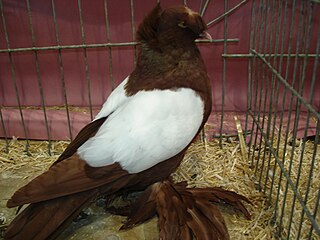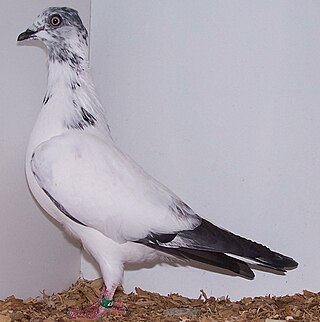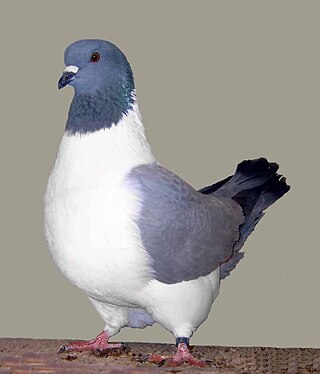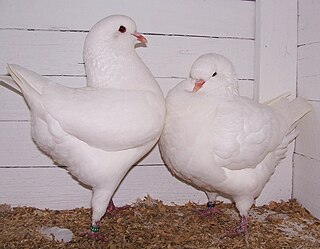There are at least four main types of competitive pigeon sport:
Fancy pigeon refers to any breed of domestic pigeon, which is a domesticated form of the wild rock dove. They are bred by pigeon fanciers for various traits relating to size, shape, color, and behavior, and often exhibited at pigeon shows, fairs and other livestock exhibits.

The Fantail is a popular breed of fancy pigeon. It is characterised by a fan-shaped tail composed of 30 to 40 feathers, abnormally more than most members of the dove and pigeon family, which usually have 12 to 14 tail feathers. The breed is thought to have originated in Pakistan, India, China, Japan or Spain. There are several subvarieties, such as the English Fantail, the Indian Fantail, and the Thai Fantail. Charles Darwin used it as one of the examples in the first chapter of his book On the Origin of Species. He believed it was a descendant of the rock dove.

The Bokhara Trumpeter is a breed of fancy pigeon developed over many years of selective breeding. Bokhara Trumpeters, along with other varieties of domesticated pigeons, are all descendants from the rock pigeon . The breed is known for its long muffed (feathered) feet and double crest.

The Dresden Trumpeter is a breed of fancy pigeon developed over many years of selective breeding.

The Pouter or Cropper pigeons are domesticated varieties of the rock dove, Columba livia, characterized by a very large, inflatable crop. They are kept as ornamental or fancy breeds, valued for their unusual appearance. There are many varieties of pouter with little in common except for the nature of the crop. The origin of the breed group is unknown, but Pouters have been bred in Europe for at least 400 years.

The American Show Racer pigeon is a breed of domestic pigeon that began in the early 1950s with the finest Racing Homers, selectively bred for their breed type. Pigeon historian Wendell Levi mentions Show Pen Racers in his book The Pigeon. He describes the early development of the breed in the United States and early breeders of the variety. In 1952, The American Show Pen Racer Club was formed at the National Show held in Des Moines, Iowa.

A roller pigeon is a domesticated breed or variety of pigeon that has been selected for its ability to tumble or roll in the air. Varieties of roller pigeons include:

The Australian Performing Tumbler (APT) is a breed of fancy pigeon.

The Arabian Trumpeter is a breed of fancy pigeon developed over many years of selective breeding. Arabian Trumpeters, along with other varieties of domesticated pigeons, are all descendants from the rock pigeon. There are several breeds of trumpeter pigeons which are known for their vocal cooing which sounds similar to laughter or trumpeting. The breeds with this ability are collectively known as "voice" pigeons.

Tumbler pigeons are varieties of domesticated pigeons that are descendants of the rock dove that have been selected for their ability to tumble or roll over backwards in flight.

The Jacobin is a breed of fancy pigeon developed over many years of selective breeding that originated in Asia. Jacobins, along with other varieties of domesticated pigeons, are all descendants of the rock pigeon. It is in the Asian feather and voice pigeon show group. The breed is known for its feathered hood over its head.

Flying/Sporting is the name of one of three main groupings of breeds of domesticated pigeons used by pigeon fanciers in the United States. The other two are Fancy and Utility.

Utility pigeons are domesticated pigeons bred to be a source of meat called squab. Squabs have been used as a food in many nations for centuries. They were bred to breed and grow quickly. Because they are bred for squab production, conformation to a show standard is usually deemed unimportant.

The Strasser is a breed of fancy pigeon developed over many years of selective breeding. Strassers, along with other varieties of domesticated pigeons, are all descendants from the rock pigeon . Apart from exhibition at pigeon shows, the breed is also used for utility purposes for producing squabs as food.

The King pigeon is a breed of pigeon developed over many years of selective breeding primarily as a utility breed. Kings along with other varieties of domesticated pigeons are all descendants from the rock dove.

The Dragoon is a breed of fancy pigeon developed over many years of selective breeding. Dragoons, along with other varieties of domesticated pigeons, are all descendants of the wild rock dove. The Dragoon was one of the breeds used in the development of the Racing Homer. A very old breed of British origin, referred to by Moore (1735).

The English Trumpeter is a breed of fancy pigeon developed over many years of selective breeding. English Trumpeters, along with other varieties of domesticated pigeons, are all descendants from the rock pigeon. This is one of the most popular breeds in the USA. The English Trumpeter is regarded as one of the most ornamental breeds of fancy pigeon. The most distinguishing feature of this breed are the very large muffs on its feet, which often grow to sizes close to its flight-feathers. Combining a tuft, crest and large muffs on their feet, they are challenging to breed. They are bred in a number of colours which are listed under self, splash and baldhead.
The Altenburger Trumpeter is a breed of fancy pigeon developed over many years of selective breeding. Altenburger Trumpeters along with other breeds of domesticated pigeons are all descendants from the rock pigeon. There are several breeds of trumpeter pigeons which are known for their vocal cooing which sounds similar to laughter or trumpeting. The breeds with this ability are collectively known as "voice" pigeons.

The Barb is a breed of fancy pigeon developed over many years of selective breeding. Barbs, along with other varieties of domesticated pigeons, are all descendants from the rock pigeon . This breed was referred to by Shakespeare. It was also referred to with an illustration in Charles Darwin's Variation of Animals and Plants under Domestication. It has been marked as cruel by many organisations due to the size of its beak which means it has trouble feeding its young and surviving.

















